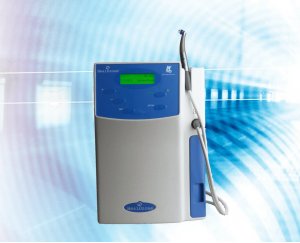Ozon therapy

Ozone therapy enables treating teeth without drill. It is indispensable in treating caries in its initial stage, with the use of biological activity of ozone, which in 10-40 seconds kills 99,9% of bacteria responsible for caries.
Treating caries in its initial stage with the drill, means removing not only decay but as well healthy dental tissues. Ozone Therapy targets caries-infected tissue, kills microorganisms and leaves decay-free tissues intact. Teeth treated with Ozone Therapy are well mineralized, and more immune to caries. The treatment is totally safe, even for children and pregnant women.
The safest dental treatment of :
• tooth fissure decay and smooth surface decay
• milk-teeth decay
• lesions on oral mucosa such as: erosions or aphtha
Currently, ozone therapy is gaining popularity as a modern non-invasive method of treatment. It is a powerful oxidizing agent with a high antimicrobial power against oral pathogens, without resistance development has been reported not only for gaseous ozone , but also for ozone in aqueous . It is used in various treatment modalities in field of medicine, dentistry, veterinary, food industry, and water treatment. Ozone is being discussed in dentistry as a possible alternative oral antiseptic agent. Its A high level of biocompatibility to fibroblasts, cementoblasts, and epithelial cells suggests its use against oral infectious diseases.
Due to the germicidal action of ozone, as well as its oxygenating power, that favors tissue regeneration, it was applied in the treatment of alveolitis following surgical extractions.
Aggressive periodontitis encompasses distinct types of periodontitis that affect people who are otherwise appear healthy . It is characterized by familial aggregation and there is a rapid rate of disease progression . An important factor in the pathogenesis of AgP is the infection of the periodontium by pathogenic bacteria which acts as a primary etiologic agent in this disease . Individuals with aggressive periodontitis are usually infected by a gram-negative anaerobic rod species. Its etiology is highly correlated to the presence of Aggregatibacter actinomycetemcomitans , host response defects ] and possibly to genetic inheritance .
Moreover, studies demonstrated that there are different microbial associations in subgingival plaques Tannerella forsythia (T. forsythia), Porphyromonas seem to be related to the progression of periodontal destruction in aggressive periodontitis [24] ; [25]. Due to the complexity of the aggressive periodontal diseases with regard to systemic factors, immune defects and microbial flora, control of the disease may not be possible in all instances. Additionally, it has the potential to cause tooth mobility and pathological tooth movement, thus effective treatment and management of those affected are necessary to slow the disease progression .
The topical application of ozone has been used in management of periodontitis but the literature regarding the direct effect of ozone on the oral tissues is still obscure . This stimulated the idea of the present work in studying the effect of using ozonated olive oil gel as an adjunctive treatment to scaling and root planing as compared to scaling and root planing alone in the treatment of localized aggressive periodontitis.
http://www.czytelniamedyczna.pl/3905,zastosowanie-ozonu-w-stomatologii.html
http://www.nature.com/bdj/journal/v200/n5/full/4813407a.html
http://www.sciencedirect.com/science/article/pii/S1687857414000183
Do you have any questions about treatment?
or call us now:

